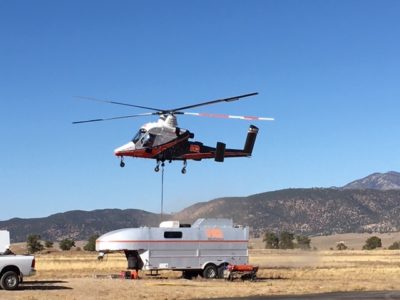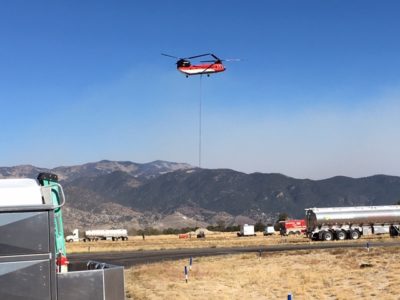The Salida Airport Committee underscored how Harriet Alexander Field played a key role in firefighting efforts during the Decker Fire at its meeting on Wednesday.
Airport manager Zech Papp told the board the airport was exceptionally busy at the height of firefighting efforts, having as many as nine to 15 aircraft on the field involved in various operations. If it had gotten much busier, officials might have had to consider closing the field to general airport operations.

The K-Max aircraft comes in for a landing after its 21st mission of the day, dropping water on the Decker Fire in 660 gal. drops. Photo by Jan Wondra.
Board member and Director of County Administration Bob Christiansen said the airport’s value as a valuable resource was proven with the firefighting operations “…we’re fortunate to have this airport here, this is a real asset…” he said.
Papp told board members fueling of the fixed-wing aircraft and helicopters resulted in 14,600 gallons of fuel sales through the month, compared with 2,500 a year ago. “The airport will post record fuel sales again this year, on a pace to top 52,000 gallons sold,” he said.
Papp said with three fires in the past three years, the airport has played a role in the firefighting efforts in each case.
Christiansen said in a discussion with an aviation expert, he had pointed out to him that rural airports are often indispensable in fighting large wildfires.
Those sentiments were echoed by Public Information Officer Terry Krasko, with a Type 1 fire team from Atlanta working the Decker Fire.

A Chinook helicopter is one of several helicopters dropping water on the Decker Fire. Photo by Jan Wondra.
Krasko said an Air Operations branch director affirmed that having the Salida airport in such close proximity with adequate fuel available was well suited for the needs of firefighters, and a huge benefit for them.
“Having logistics and support like we got from the airport was very, very convenient for us, and we did appreciate it,” he said.
Krasko said the hundreds of firefighters at their encampment were appreciative of all the expressions of gratitude that have come from the community.
“We got thank you posters and letters and cards all over our briefing area, and the signs that are posted around town…we know, and we appreciate that so much.”
Krasko, who has fought fire in 34 states, also works with community fire mitigation assistance teams sponsored by the Forest Service, working with citizens in communities to plan mitigation efforts that can be done by private citizens.
Papp recently met with Federal Aviation Administration and Colorado Department of Transportation officials regarding the shared federal funding for rural airports, which next year will give Harriet Alexander Field some $660,000.

Harriet Alexander Field Airport Manager Zechariah Papp flies with Keaston McNeill. Children ages 8-17 may fly with a pilot as part of International Young Eagles Day Saturday, June 9 (courtesy photo).
Papp’s priority would be to build a needed second taxiway extension, based on the number of aircraft utilizing the field – 42, and with more 7,000 flight operations conducted this year.
His challenge is to convince the FAA to use supplemental funds to fund the taxiway extension. Aircraft now have to use the main runway while taxiing for takeoff, which is considered a safety issue.
He said while the airport master plan is being finalized, the $660,000 in FAA funds in 2020 can be utilized for planning, design and environmental impact work for the project. He cautioned the board that the FAA might not feel ready to fund the estimated $7 million project with supplemental funding at this point, though they do want to see projects with the preliminary design work completed.
In other action, the board selected July 11th as the date for the annual Fly-in event, so as not to conflict with other local events earlier in the summer.






Recent Comments